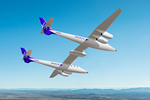Aurora expands aerospace composites manufacturing facility
Bridgeport facility has been increased to approximately 227,000 square feet to better engage with current and new production programs.
At the end of April 2024, Aurora Flight Sciences (Bridgeport, W.Va., U.S.), a Boeing Company, celebrated the expansion of its advanced manufacturing facility in Bridgeport, West Virginia. The expansion adds almost 50,000 square feet to the facility and supports significant growth for building high-quality composite components and assemblies across both current production programs and new opportunities in the aerospace industry.
The facility manufactures components and systems for aircraft such as the MQ-25 Stingray, T-7A Red Hawk and military helicopters. Earlier this year, Aurora announced that the West Virginia facility will build the airframe for the Defense Advanced Research Projects Agency’s (DARPA) X-65 active flow control demonstrator aircraft and will provide the transonic-truss-braced wing assembly for NASA’s X-66 sustainable flight demonstrator aircraft.
In 1994, Aurora opened its first West Virginia location, a 68,000-square-foot composite materials and prototyping facility, in Fairmont. The company moved to the Bridgeport location in 1999, starting with a single building and growing into the six-building campus the company has today. This latest expansion increases the facility’s footprint to approximately 227,000 square feet and includes doubling the size of the cleanroom, adding another autoclave, installing permanent freezers and creating adequate space to safely implement point-of-use tooling. The site is already home to technology such as a robotic composites manufacturing cell, which uses robots for precise part machining, transport and dimensional inspection.
“Fifteen years ago, I started my Aurora career in Bridgeport, and I am proud to continue our investment in this community,” says Luke Colville, vice president of manufacturing and aerosystems at Aurora Flight Sciences. “We are adding capacity to support today’s defense aircraft programs and to build experimental aircraft that will advance the technologies of tomorrow. I want to thank our customers for choosing to grow their business with us and our Aurora team members whose hard work and expertise are critical to our success.”
Over the next 5 years, Aurora also plans to grow its workforce in West Virginia from 200 to more than 300 team members. Aurora provides on-site training for new team members and works with local vocational programs, community colleges and universities to connect students with employment opportunities. Recently, Aurora participated in the University of West Virginia’s STEM Career Fair, Career Day at Grafton High School, and the Pierpont Community and Technical College Aviation Career Fair.
Related Content
-
Welding is not bonding
Discussion of the issues in our understanding of thermoplastic composite welded structures and certification of the latest materials and welding technologies for future airframes.
-
Plant tour: Joby Aviation, Marina, Calif., U.S.
As the advanced air mobility market begins to take shape, market leader Joby Aviation works to industrialize composites manufacturing for its first-generation, composites-intensive, all-electric air taxi.
-
PEEK vs. PEKK vs. PAEK and continuous compression molding
Suppliers of thermoplastics and carbon fiber chime in regarding PEEK vs. PEKK, and now PAEK, as well as in-situ consolidation — the supply chain for thermoplastic tape composites continues to evolve.

















